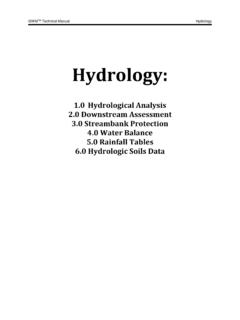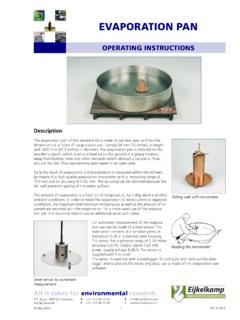Transcription of Chapter 4 Soil Properties - David Tarboton
1 Copyright 2003 David G Tarboton , Utah State University Chapter 4 soil Properties Rainfall-Runoff Processes Chapter 4: 1 Chapter 4: soil Properties Infiltration is the movement of water into the soil . This is possible, because soil is not solid matter; instead it is a porous medium comprising a matrix of solid granular particles and voids that may be filled with air or water (Figure 21). Flow in a porous medium may be unsaturated when some of the voids are occupied by air, or saturated when all the voids are occupied by water. Considering the cross section of a porous medium illustrated in Figure 21, the porosity is defined as volumetotalvoidsofvolumen= (6) Figure 21. Cross section through an unsaturated porous medium (from Chow et al., 1988).
2 The range of n for soils is approximately to depending upon the soil texture. A part of the voids is occupied by water, and the remainder by air. The volume occupied by water being measured by the volumetric soil moisture content is defined as volumetotalwaterofvolume= (7) Hence 0 n; the soil moisture content is equal to the porosity when the soil is saturated. soil moisture content is also sometimes characterized by the degree of saturation, defined as Sd = /n (8) The degree of saturation varies between 0 and 1. Rainfall-Runoff Processes Chapter 4: 2 Referring to Figure 21, the soil particle density, m, is the weighted average density of the mineral grains making up a soil m= Mm/Vm (9) where Mm is the mass and Vm the volume of the mineral grains.
3 The value of m is rarely measured, but is estimated based on the mineral composition of the soil . A value of 2650 kg/m3, which is the density of the mineral quartz, is often assumed. The bulk density, b, is the dry density of the soil mwamsmbVVVMVM++== (10) where Vs is the total volume of the soil sample which is the sum of the volume of the air, Va, liquid water, Vw, and mineral components, Vm, of the soil respectively. In practice, bulk density is defined as the mass of a volume of soil that has been dried for an extended period (16 hr or longer) at 105 oC, divided by the original volume. The porosity (6) is given by mbmmsmsmsswa1V/MV/M1 VVVVVVn = = =+= (11) and n is usually determined by measuring b and assuming an appropriate value for m. Laboratory determination of volumetric moisture content is by first weighing a soil sample of known volume, oven drying it at 105 oC, reweighing it and calculating swsdryswetVMM = (12) Here Mswet and Msdry are the masses before and after drying, respectively, and w is the density of water (1000 kg/m3).
4 This method for determining soil moisture is referred to as the gravimetric method. In the field moisture content can be measured in a number of other ways. Electrical resistance blocks use the inverse relationship between water content and the electrical resistance of a volume of porous material ( gypsum, nylon or fiberglass) in equilibrium with the soil . Neutron probe moisture meters are combined sources and detectors of neutrons that are inserted into Rainfall-Runoff Processes Chapter 4: 3 access tubes to measure the scattering of neutrons by hydrogen atoms, which is a function of moisture content. Gamma-ray scanners measure the absorption of gamma rays by water molecules in soil between a source and a detector. Capacitance and time-domain reflectometry (TDR) techniques measure the dielectric property of a volume of soil , which increases strongly with water content.
5 Nuclear magnetic resonance techniques measure the response of hydrogen nuclei to magnetic fields. Remote sensing and specifically, microwave remote sensing can provide information about surface soil water content over large areas. Both active and passive microwave systems exist, with active systems (radar) having higher resolution. Because of the importance of soil moisture in hydrologic response, as well as land surface inputs to the atmosphere, the relationship of soil moisture to remote sensing measurements is an area of active research. The assimilation of remote sensing measurements of soil moisture into hydrologic and atmospheric forecasting models is one exciting aspect of this research that holds the potential for improving hydrologic and atmospheric model forecasts. For details on these methods for soil moisture measurement the reader is referred to soil physics texts, or the research literature ( , Hillel, 1980) The flow of water through soil is controlled by the size and shape of pores, which is in turn controlled by the size and packing of soil particles.
6 Most soils are a mixture of grain sizes, and the grain size distribution is often portrayed as a cumulative-frequency plot of grain diameter (logarithmic scale) versus the weight fraction of grains with smaller diameter (Figure 22). The steeper the slopes of such plots, the more uniform the soil grain-size distribution. For many purposes the particle size distribution is characterized by the soil texture, which is determined by the proportions by weight of clay, silt and sand. Clay is defined as particles with diameter less than mm. Silt has a particle diameter range from mm to mm and sand has particle diameter range from to 2 mm. Figure 23 gives the method developed by the Department of Agriculture for defining textures based on proportions of sand, silt and clay. Larger particles with grain sizes greater than 2 mm are excluded from this proportioning in the determination of texture.
7 Grain size distributions are obtained by sieve analysis for particles larger than mm and by sedimentation for smaller grain sizes. Sieve analysis is a procedure where the soil is passed through a stack of successively finer sieves and the mass of soil retained on each sieve is recorded. Because soil grains are irregular shapes, the practical Rainfall-Runoff Processes Chapter 4: 4 definition of diameter then amounts to whether or not the soil grain passes through a sieve opening of specified size. Sedimentation is a procedure whereby the settling rate in water of soil particles is measured. For details see a soil physics reference ( Hillel, 1980). (mm)Percentage finer by weightClaySiltSandGravelUniformly graded sandWell graded silt, sand, gravel mixtureFigure 22. Illustrative grain-size distribution curves. The boundaries between size classes designated as clay, silt, sand and gravel are shown as vertical lines.
8 Following are the grain sizes used for the determination of texture for the soils illustrated in Figure 22. Diameter (mm) A. % Finer B. % Finer A. % Finer < 2mm only B. % Finer < 2mm only 50 100 100 19 95 100 90 100 84 98 2 75 95 100 100 64 80 42 10 56 20 4 7 2 2
9 1 Rainfall-Runoff Processes Chapter 4: 5 AB Figure 23. soil texture triangle, showing the textural terms applied to soils with various fractions of sand, silt and clay (Dingman, Physical Hydrology, 2/E, 2002. Electronically reproduced by permission of Pearson Education, Inc., Upper Saddle River, New Jersey) soil A is a well-graded mixture comprising gravel, silt and sand in roughly equal proportions. The majority of grains in soil B are all from the same sand size class. It is therefore described as uniformly graded sand. The percentages of Sand, Silt and Clay, for these soils determine the texture as indicated by the dots in Figure 23 A B % Sand % Silt % Clay Texture (Figure 23) Sandy Loam Sand The soil Properties , porosity, moisture content, bulk density are defined in terms of averages over a volume referred to as the representative elementary volume (Bear, 1979).
10 It is not meaningful, for example, to talk about these quantities as a very small scale where we are looking at individual soil grains or particles. These Properties Rainfall-Runoff Processes Chapter 4: 6 (and others such as hydraulic conductivity and specific discharge to be defined below) represent averages over the representative elementary volume and are referred to as continuum Properties of the porous medium. The macroscopic continuum representation of flow through a porous medium relies on this concept to overlook the complexity of the microscopic flow paths through individual pores in a porous medium (see Figure 24). Typically the representative elementary volume is about 1 to 20 cm3. Where heterogeneity exists in a porous medium at all scales, the definition of macroscopic continuum Properties can be problematic. At the macroscopic scale, flow through a porous medium is described by Darcy's equation, or Darcy's law.





